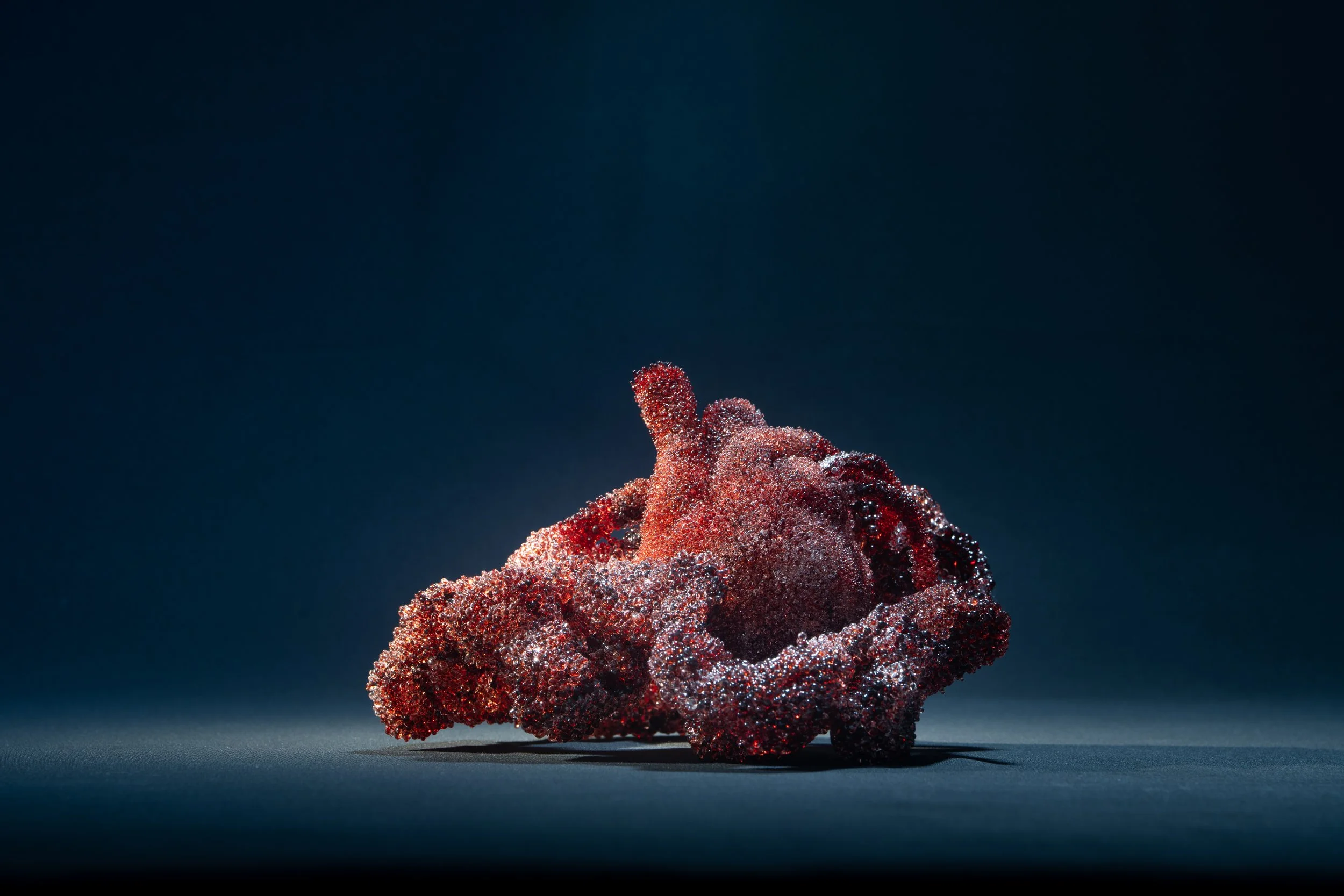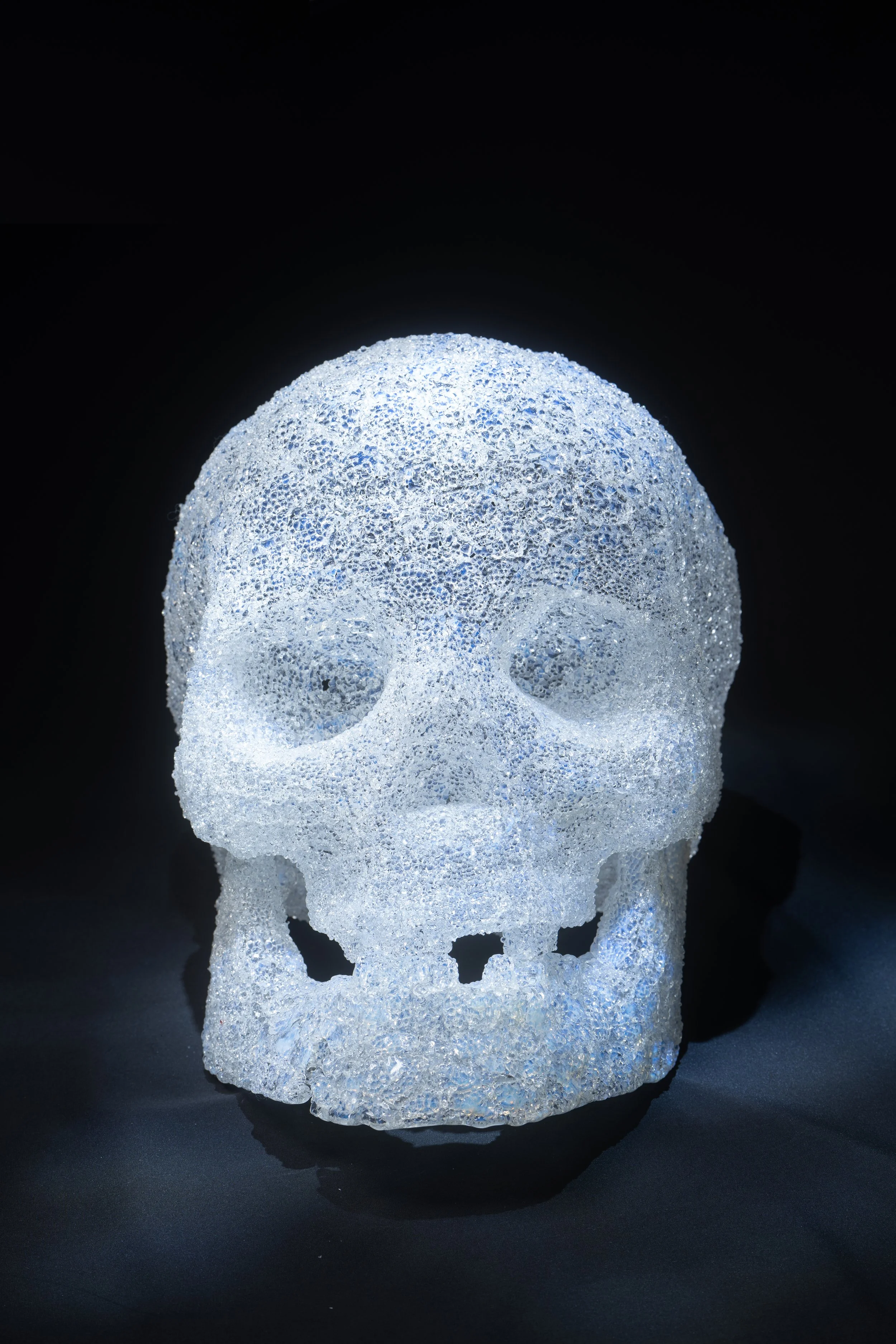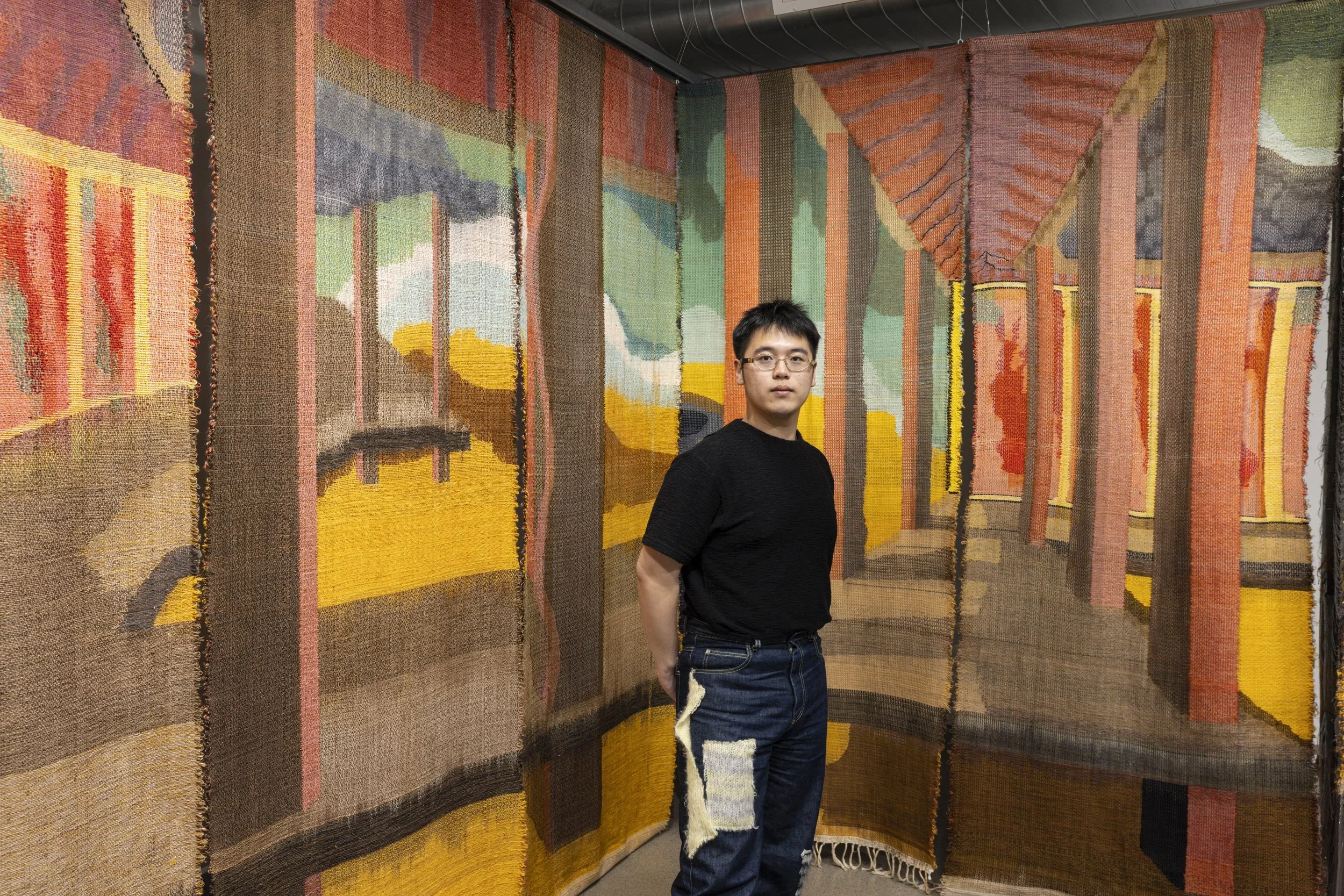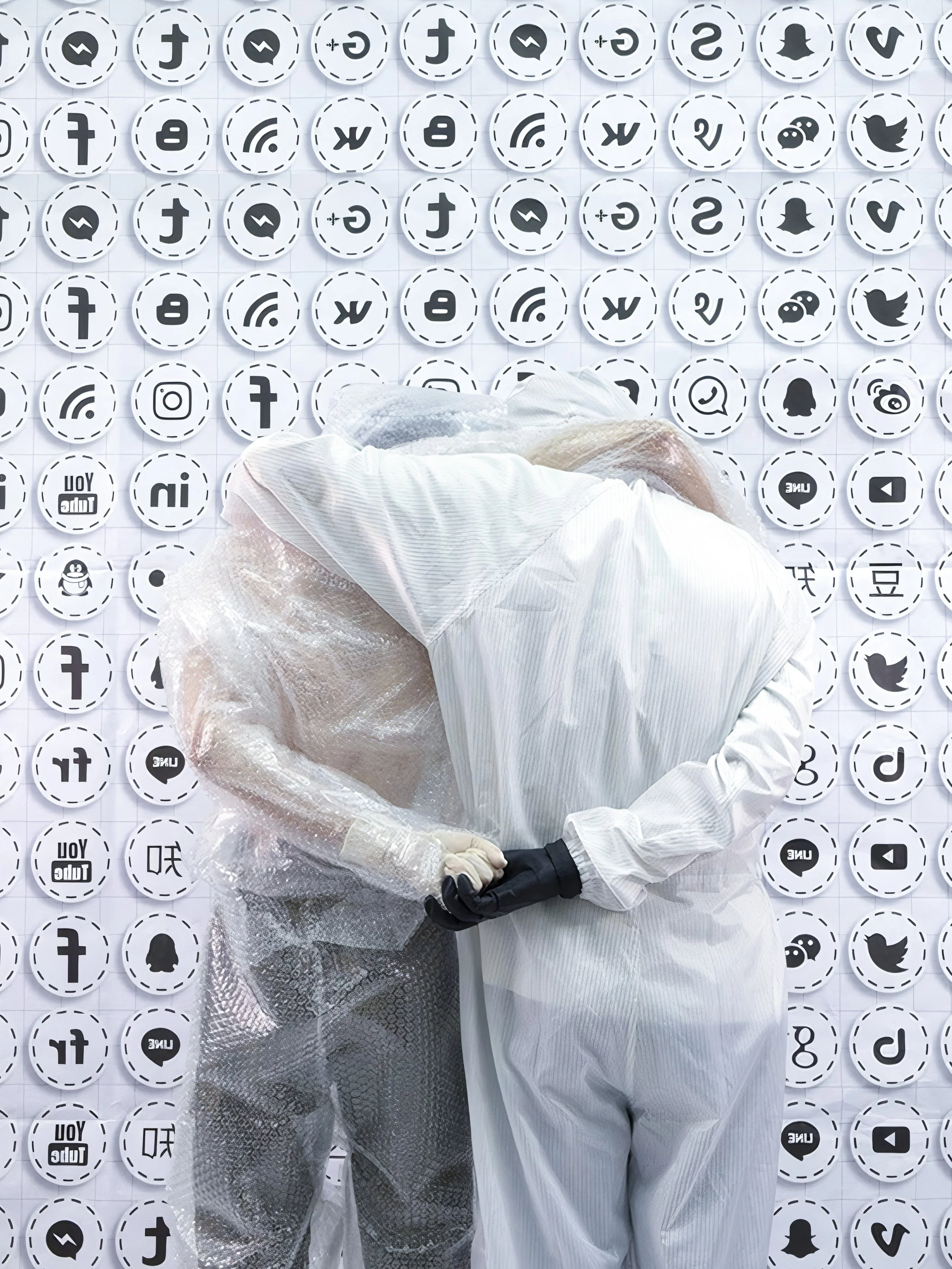10 Questions with Jietong Xu
Al-Tiba9 Art Magazine ISSUE16 | Featured Artist
Jietong Xu is currently studying Ceramics and Glass at the Royal College of Art (RCA). She previously earned a degree in Illustration and Visual Media from UAL LCC, where she developed a passion for integrating illustration with diverse materials. Her work focuses on transforming imagined worlds into tangible realities, using glass as her primary medium and flames as her brush.
Jietong Xu - Portrait
ARTIST STATEMENT
Jietong Xu's artwork delves into the emotional connections between individuals through the medium of glass. Inspired by the intricate dynamics within her own family, she uses glass weaving techniques to bring thoughts and emotions to life. By wielding flames as her brush, she transforms glass into a medium that captures the delicate yet resilient nature of human relationships. Her pieces reflect the complex interplay of support and conflict, aiming to evoke empathy and introspection. Through her art, she invites viewers to reflect on their own relationships and the healing power of human connection.
Interwoven Will, Borosilicate Glass, 18x15x12 cm, 2024 © Jietong Xu
This project explores the relationship between individuals and the collective. Using hearts as visual elements, Jietong Xu employs glass weaving techniques to materialize human thoughts. The inspiration comes from the complex emotional relationship between the artist and her mother, reflecting the subtle dynamics within a family. To deepen the concept, she studied Confucian views on family and referenced Bowenian family systems theory. In the artwork, hearts are used as symbols, representing the core of life and emotion. Each piece consists of one to three hearts, forming spherical objects through different weaving methods. Ultimately, these small pieces come together to form a series, providing a direct comparison between the collective and the individual. Through interweaving these glass hearts, the artist hopes viewers can feel the emotional support and conflicts in family relationships and the process of finding self-identity within the collective.
AL-TIBA9 ART MAGAZINE ISSUE16
INTERVIEW
Please introduce yourself to our readers. Who are you, and how did you first become interested in art?
My name is Jietong Xu, and I am currently focused on glass art. I first encountered drawing at a very young age, and for a long time, it was a way to release pressure. My parents saw it as a 'waste of time' that was not worthy of their approval. My drawings often appeared not in sketchbooks but on exam papers or scraps of paper, which, in hindsight, was a form of rebellion against my parents' expectations. Through persistence and the support of a middle school art teacher, I truly began to engage with art in a more structured way. The weekend art classes became the extracurricular activity I looked forward to the most, offering me a sense of anticipation and relaxation.
Interwoven Will, Borosilicate Glass, 18x15x12 cm, 2024 © Jietong Xu
As you mention in your biography, you first studied Illustration and Visual Media at UAL LCC before moving to Ceramics and Glass at RCA. What inspired this transition, and how does it influence your artistic approach?
I have always enjoyed transforming imagined worlds into tangible realities in my artistic practice. Inspired by my love for line work and the influence of anime during my childhood, I have focused on digital art. Compared to traditional forms of painting, digital art offers a more efficient way to create, and these factors together have shaped my artistic style.
My inspiration mainly comes from the details of everyday life. I enjoy exploring interpersonal relationships, the individual and the collective interaction, and how these relationships evolve within a broader social context. Art is a tool for self-expression and a bridge for communication and connection, closely tied to the times and the environment. I want my work to engage in a dialogue with viewers and contemporary society, as this connection is also a part of my creative process.
However, I have realised that every form of creation has limitations. My previous focus on digital art could not satisfy my desire for the language of materials, tactile experience, and spatial expression. The simultaneous fragility and resilience of glass made me aware of its complexity, and I believe in the potential of glass to express emotions and relationships. This realisation prompted me to explore the boundaries between illustration and glass.
In your current work, you use primarily glass weaving techniques. Can you describe your creative process from start to finish when working on a new piece?
I choose to express my works in pure glass because the complexity of glass gives my work more emotional depth and materiality. After determining the theme and direction, I conduct small-scale experiments to observe the effects of different techniques on glass and evaluate the feasibility of various approaches. I follow the principles of Automatism, avoiding over-planning the final form and structure, and instead begin creating once individual elements are decided.
To some extent, I rely on intuition in my creative process, particularly in my project 'Interwoven Will.' After gathering and concluding the interviewees' stories, I start creating. At the same time, the emotions are still vivid and impactful, allowing these intuitive feelings to guide my manipulation of the glass, winding and shaping it as though I were tracing the contours of the emotions themselves. What I want to express already exists in my subconscious, and research serves as a language to help organize my thoughts. For me, research is a form of exploration.
Interwoven Will, Borosilicate Glass, 18x15x12 cm, 2024 © Jietong Xu
Interwoven Will, Borosilicate Glass, 18x15x12 cm, 2024 © Jietong Xu
You also mention in your statement how your work aims to transform "imagined worlds into tangible pieces." How do you do this? And what is the ultimate message you want to convey?
In my work, transforming imagined worlds into tangible creations is a way of materializing deeply felt emotions and thoughts. The transparency and fragility of glass convey the layers and complexities of emotions. Through meticulous control of light, shadow, and form, I transform those ineffable emotions into concrete visual symbols. In this process, symbolism becomes crucial; I aim to use these tangible elements to help viewers find reflections of real emotions within the work. The image of the heart embodies the core of emotion, the woven structures represent the entanglements and connections within relationships, and the textured fragments symbolize the process of rupture and subsequent regeneration. These elements enhance the aesthetic depth of the work and provide viewers with an entry point into the emotional world, enabling them to find resonance with their own experiences and establish a connection with the piece.
Let's talk more specifically about your recent works, like Interwoven Will. Could you explain the significance of using hearts as visual elements in this work?
In my work, the heart symbolizes individual family members. The glass clusters represent the close ties and interdependence emphasized in Confucian family ethics. These glass clusters support the heart, allowing it to stand prominently, reflecting the support and collaboration among family members. However, these supports also obscure part of the heart, symbolizing the emotional entanglements in Bowen's theory that can engulf the individual.
Through this visual expression, I aim to depict how individuals seek the balance between emotional support and entanglements within the family.
Reconstructed Fragments, Borosilicate Glass, 40x50x38 cm, 2024 © Jietong Xu
Reconstructed Fragments is a project that explores the connections between human individuals. The inspiration came from a trip where Jietong Xu saw real human bones damaged by disease or injury. These damaged bones triggered her thoughts on how human connections are formed and sustained.
By presenting damaged glass skulls, the artist aims to symbolize the enduring nature of individual traumas and experiences. The act of retaining these damages, rather than repairing them, highlights the raw and unfiltered connections between individuals. This process is akin to deconstruction and reconstruction, allowing viewers to explore and interpret the artwork, engaging with the visible fractures and imperfections that mirror real-life vulnerabilities.
This project seeks to create a dialogue that transcends words, fostering a deeper understanding and connection among viewers. These connections may surpass the boundaries of race, region, and culture, and are built on direct interaction and mutual understanding. By exploring these links, "Reconstructed Fragments" illustrates how individual connections are established and developed.
Reconstructed Fragments, Borosilicate Glass, 40x50x38 cm, 2024 © Jietong Xu
How do Confucian views on family and Bowenian family systems theory inform this project?
Confucian family values emphasize mutual support and dependence among family members, while Bowen's theory reveals the complexity and self-identity challenges these close ties can bring. By combining these two theories, my work seeks to illustrate the dual nature of family emotional relationships—providing support and protection while alsopotentially causing constraint and emotional pressure.
Moving to Reconstructed Fragments, what led you to associate the theme of human connections with damaged glass skulls?
In this project, empathy serves as both the source of inspiration and the foundation for linking the theme of human relationships with damaged glass skulls. Empathy allows individuals to experience the emotions and experiences of others, directly fostering connections between them. This curiosity about the origins of such empathy led me to explore how the damage to these skulls came to be. During this exploration, I realized that I had established a one-sided connection with the skulls—these marks seem like messages left by the deceased, waiting for us to interpret them across decades or even centuries.
I presented damaged glass skulls to symbolize the enduring nature of individual trauma and experiences. By preserving rather than repairing these damages, the work emphasizes genuine connections and unfiltered vulnerability between individuals. Viewers are invited to explore and interpret the art, engaging with the visible fractures and imperfections that reflect real-life fragility.
Reconstructed Fragments, Borosilicate Glass, 40x50x38 cm, 2024 © Jietong Xu
The project is still in progress; how do you see it evolving over time? Do you plan to add different pieces or introduce reproductions of different bones?
I am open to the future direction of this project, but for now, I do not plan to expand to other body parts. The project's current stage has already fully conveyed the core message I intended to express, but artistic creation is a continually evolving process. I believe this project may develop new possibilities over time and with new sources of inspiration, further deepening and expanding its themes. I remain open to future creative opportunities and look forward to revisiting and developing this project from new perspectives as my understanding of human relationships deepens.
Speaking of the future, are there any new themes or techniques you are excited to explore in your upcoming projects?
I plan to continue deepening my understanding and skills in lampworking glass, but I am also inquisitive about other glass techniques. In particular, I am eager to experiment with pâte de verre in my future works. Although both techniquesinvolve glass, they result in distinctly different textures in the final presentation. Additionally, I am very interested in combining illustration with traditional glass techniques, and I plan to explore the possibilities of this interdisciplinary approach in my future creations.
And lastly, what can we expect from your future exhibitions or collaborations?
I am currently exhibiting some of my works in MilanoVetro -35, and in September, I will be participating in the RCA C&G 2024 Alumni Exhibition, where I will showcase my latest works.

























